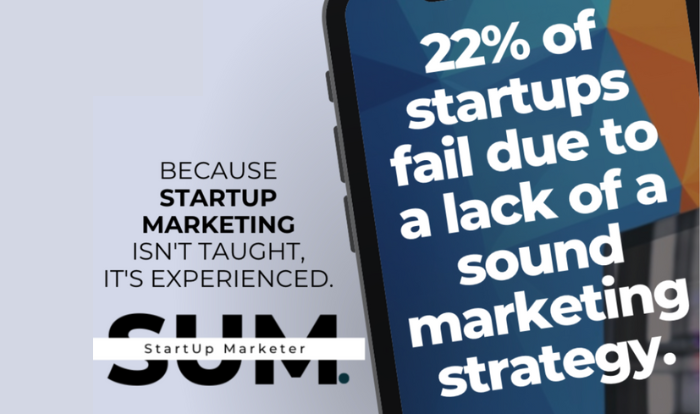When you’re a marketer at a startup, you often wear many hats. You’re racing against timelines, varying priorities, and limited resources. But, all that time spent executing and moving on to the next deliverable may hinder your marketing organization’s ability to be a true strategic partner for your startup.
You need to get off the hamster wheel and onto a more strategic path, so your startup doesn’t become one of the 90% that fail within their first 10 years. And how do you do that? By building a holistic marketing strategy that helps your business scale. The proof’s in the data: Startups with a documented marketing plan grow 30% faster than those without.
Your holistic marketing strategy has three foundational elements:
- Diagnosis
- Guiding Policy
- Coherent Action
In this post, we’ll explain exactly how you can execute all these foundations to transform marketing from a cost-center to a revenue-driver.
Step 1 to Your 3-Part Holistic Strategy: Diagnosis
The first step of your holistic marketing strategy: diagnosis. This is when you understand the exact challenge you’re looking to solve. Often, you may hear, “We need more content or a splashy new video.” Before putting resources toward executing that ask, you need to get to the root of the challenge. And to do that, you have to do your homework. That starts with gaining insight into your startup’s DNA, from your product lines to your competitors to your sales cycle. You’ll need to get the rundown on your ideal customer profile—where are they located? Who are the influencers versus decision-makers? What does their day-to-day life look like? What do they care about?
Marketing’s close alignment with the sales organization becomes crucial. However, many companies struggle to build that strong marketing-sales connection with 35% of marketers saying that communication between sales and marketing is their top challenge. However, the companies that get this relationship right see major gains; companies with interconnected, collaborative sales and marketing teams experience a 27% faster path to profit. Regularly engaging with sales gives you direct insight into your target audience, from their most pressing challenges to what they look for in a product to why they say yes or even no to your business.
In addition to sales, regularly engage with your leadership team to understand how they define success for your startup in terms of the targets they’re striving for over the next three, six, and 12 months. Ask them what metrics they use to understand success so you can speak the same language. Suppose leadership is measuring success based on net new dollars in the door, and you’re talking to them about video impressions.In that case, this will create a disconnect and a potentially fractured relationship between marketing and leadership. Align your strategy’s measurements of success against how your startup measures success.
Step 2 to Your 2-Part Holistic Strategy: Guiding Policy
After you’ve done your research and engaged with internal stakeholders, you can jump into step two: guiding policy. Your guiding policy is essentially your elevator pitch of what you are doing. We want to emphasize what it is not: a guiding policy is not the channels or tactics you implement. For example, saying, “We are going to build brand awareness by writing blog posts and amplifying them on social media.” is not a strong guiding policy.
Alternatively, this is how you could reframe it to become a guiding policy, We will generate net new revenue by reaching and engaging audiences throughout their journey to build connections that translate to accelerated sales cycles and move them through the funnel from lead to won.”
You may be wondering—why does this matter? It matters because you need to go beyond the “what” and focus on the “why.” By doing this, your entire team can align to a centralized and specific goal that every activity you pursue ladders back to.
To develop your guiding policy, you have to have a deep understanding of your customer behavior throughout each lifecycle phase, from awareness to purchase. Keep an eye out for a SUM training coming soon that will dive into a list of questions you should answer at each stage, like where your audience spends their time, what language they use to search for a product, and more.
Step 3 to Your 3-Part Holistic Strategy: Coherent Action
Here comes the fun part: coherent action. You understand the challenge, you have your goal, and now you can dive into execution. During this phase, you’ll build a distribution plan that details the tactics you’ll use, the types of content you’ll develop, and how you’ll measure success. Having that guiding policy is critical here as you can ensure everything you do goes toward achieving that goal.
You can align your tactics and content to different stages of the audience journey, such as distributing a blog post on your social, website, and newsletter about a hairy challenge pervasive in your industry. With this approach, you target the top of the funnel to build your market reputation, and you can gauge success through impressions, views, website traffic, and more. However, if you wanted to get marketing qualified leads (MQL) over the finish line to closed-won, you could consider launching an email nurture campaign to target the bottom of the funnel, using metrics like MQL to sales qualified lead (SQL) or the number of closed deals to ascertain whether you were successful. Use your guiding principle as you develop your action plan to ensure you’re optimizing your team’s time, resources, and talents.
Armed with this three-part strategy, you’re able to transform your role as a marketing organization. You’re not solely activity-generators, but impact-generators. Marketing becomes a revenue-center, making you an indispensable strategy part for your startup. It all comes down to those key fundamentals.
In the realm of startup marketing, sending generic campaigns is a perilous misstep. The solution? Segmentation strategies. Dive into our Read more
Learn how startup marketers can perfect the art and science of prioritization in this StartUp Marketer blog post.
Startup success requires understanding marketing’s fundamentals, like taking a customer-centric approach. Learn more on The StartUp Marketer blog.
Many startups overlook the importance of ongoing SEO optimizations. However, there are 5 reasons why they are a crucial marketing Read more





